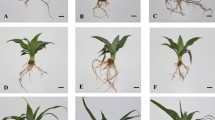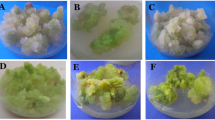Abstract
Codonopsis lanceolata Benth. et Hook. f., commonly known as bonnet bellflower, is a high-valued herb medicine and vegetable. In this study, a large number of plants were regenerated via organogenesis from immature seed-derived calli in C. lanceolata by a simple and efficient method. Compared with the mother donor plant, the regenerated plants did not exhibit visible phenotypic variations in six major morphological traits examined at the stage of one-season-maturity under field conditions. To gain insight into the genomic stability of these regenerated plants, 63 individuals were randomly tagged among a population of more than 2,000 regenerants, and were compared with the single mother donor plant by two molecular markers, the inter-simple sequence repeats (ISSR) and randomly amplified polymorphic DNA (RAPD). Apparent genomic variation was detected in the 63 regenerants, whereas preexisting heterozygosiy in the donor plant was deemed minimal by testing 30 seedlings germinated from selfed seeds of the same donor plant. The percentages of polymorphic bands (PPB) in the ISSR and RAPD analysis were respectively 15.7 and 24.9% for the 63 regenerated plants. Cluster analysis indicates that the genetic similarity values calculated on the basis of RAPD and ISSR data among the 64 plants (63 regenerated and one donor) were respectively 0.894 and 0.933, which allow classification of the plants into distinct groups. Nineteen randomly isolated bands underlying the changed RAPD or ISSR patterns were sequenced, and three of them showed significant homology to known-function genes. Detailed pairwise sequence comparison at one locus between the donor plant and a regenerant revealed that insertion of two short (24 and 19 bp) stretches of nucleotides in the regenerated plant relative to the donor plant occurred in an apparently stochastic manner.







Similar content being viewed by others
Abbreviations
- 6-BA :
-
6-Benzylaminopurine
- CTAB :
-
Cetyl trimethylammonium bromide
- GA 3 :
-
Gibberellic acid
- IBA :
-
Indole-butyric acid
- ISSR :
-
Inter-simple sequence repeat
- MS :
-
Murashige and Skoog's medium
- NAA :
-
α-Naphthalene acetic acid
- RAPD :
-
Randomly amplified polymorphic DNA
- UPGMA :
-
Unweighted pair group method with arithmetic averaging
References
Altschul SF, Madden TL, Schaffer AA, Zhang J, Zhang Z, Miller W, Lipman DJ (1997) Gapped BLAST and PSI-BLAST: a new generation of protein database search programs. Nucleic Acids Res 25:3389–3402
Bertin P, Bouharmont J, Kinet JM (1997) Somaclonal variation and improvement of chilling tolerance in rice: changes in chilling-induced chlorophyll fruorescence. Crop Sci 37:1727–1735
Brown PTH, Lange FD, Krang E, Lorz H (1993) Analysis of single protoplasts and regenerated plants by PCR and RAPD technology. Mol Gen Genet 237:311–317
Cassells AC, Curry RF (2001) Oxidative stress and physiological, epigenetic and genetic variability in plant tissue culture: implications for micropropagators and genetic engineers. Plant Cell Tissue Organ Cult 64:145–157
Diwan N, Cregan PB (1997) Automated sizing of fluorescent labeled simple sequence repeat (SSR) markers to assay genetic variation in soybean. Theory Appl Genet 95:723–733
Han EG, Cho SY (1997) Effect of Codonopsis lanceolata water extract on the activities of antionxidative enzymes in carbon tetrachloride treated rats. J Koreon Soc Food Sci Nutr 26:1181–1186
Hirochika H (1993) Activation of tobacco retrotransposons during tissue culture. EMBO J 12:2521–2528
Hirochika H, Sugimoto K, Otsuki Y, Tsugawa H, Kanda M (1996) Retrotransposons of rice involved in mutations induced by tissue culture. Proc Natl Acad Sci USA 93:7783–7788
Hollander M, Wolfe DA (1973) Nonparametric statistical methods, Wiley, New York
Hong DY, Lian YS, Shen LD (1984) In: Hong DY (ed) Flora reipublicae popularis sinicae, vol. 73, Science Press, Beijing, pp 37–38
Kaeppler SM, Kaeppler HF, Rhee Y (2000) Epigenetic aspects of somaclonal variation in plants. Plant Mol Biol 43:179–188
Kidwell KK, Osborn TC (1992) Simple plant DNA isolation procedures. In: Beckman JS, Osborn TC (eds) Plant genomes: methods for genetic and physical mapping, Kluwer Academic Publishers, Amsterdam, pp 1–13
Kunkel G (1984) Plants for Human Consumption, Koeltz Scientific Books, Koenigsten, Germany
Larkin PJ, Scowcroft WR (1981) Somaclonal variation: a novel source of variability from cell cultures for plant improvement. Theory Appl Genet 60:197–214
Li YS, Li HL, An JH, Li LH, Shu YM (2003) Morphology and germination of C. lanceolata. J Agri Sci Yanbian Uni 25:155–158
Linacero R, Vazquez AM (1992) Genetic analysis of chlorophyll-deficient somaclonal variants in rye. Genome 35:981–984
Müller E, Brown PTH, Hartke S, Lörz H (1990) DNA variation in tissue-culture derived rice plants. Theory Appl Genet 80:673–679
Murashige T, Skoog F (1962) A revised medium for rapid growth and bioassays with tobacco tissue cultures. Physiol Plant 15:473–497
Nagaoka T, Ogihara Y (1997) Applicability of inter-simple sequence repeat polymorphisms in wheat for use as DNA markers in comparison to RFLP and RAPD markers. Theory Appl Genet 94:597–602
Nayak S, Debata BK, Srivastava VK, Sangwan NS (2003) Evaluation of agronomically useful somaclonal variants in Jamrosa (a hybrid Cymbopogon) and detection of genetic changes through RAPD. Plant Sci 164:1029–1035
Peschke VM, Phillips RL, Gengenbach BG (1987) Discovery of transposable element activity among progeny of tissue culture-derived maize plants. Science 238:804–807
Phillips RL, Kaeppler SM, Olhoft P (1994) Genetic instability of plant tissue cultures: Breakdown of normal controls. Proc Nati Acad Sci USA 91:5222–5226
Piao S (1991) The function and utilization of Korean traditional vegetables. The Encyclopedia Press, Seoul, 56 pp
Rahman MH, Rajora OP (2001) Microsatellite DNA somaclonal variation in micropropagated trembling aspen (Populus tremuloides). Plant Cell Rep 20:531–536
Rani V, Parida A, Raina SN (1995) Random amplified polymorphic DNA (RAPD) markers for genetic analysis in micropropagated plants of Populus deltoides marsh. Plant Cell Rep 14:459–462
Rohlf FJ (1993) NTSYS-pc: numerical taxonomy and multivariate analysis system. Exeter Publishing Ltd., New York, USA
Rohlf FJ (1997) NTSYSpc: numerical taxonomy and multivariate analysis system, version 2.02. Exeter Software, Setauket, New York, USA
Rout GR, Samantaray S, Das P (2000) In vitro manipulation and propagaton of medicinal plants. Biotech Adv 18:91–120
Sato F, Shigematsu Y, Yamada Y (1988) Selection of an atrazine-resistant tobacco cell line having a mutant psbA gene. Mol Gen Genet 214:358–360
Shimomura K, Yoshimatsu K, Jaziri M, Ishimaru K (1997) Traditional medicinal plant genetic resources and biotechnology applications. Plant Biotechnology and Plant Genetic resources for Sustainability and Productivity (Series: Biotechnology Intelligence Unit), pp 209–225
Sneath PHA, Sokal RR (1973) Numerical taxonomy: the principles and practice of numerical classification. Freeman WH, San Francisco, 573 pp
Strand M, Prolia TA, Liskay RM, Petes TD (1993) Destabilization of tracts of simple repetitive DNA in yeast by mutations affecting DNA mismatch repair. Nature 365:274–276
Thompson JD, Gibson TJ, Plewniak F, Jeanmougin F, Higgins DG (1997) The CLUSTAL-X windows interface: flexible strategies for multiple sequence alignment aided by quality analysis tools. Nucleic Acids Res 25:4876–4882
Wang YF, Nie XL, Hu GX (1996) A study on seed germination rate of Codonopsis lanceolata. Chin Wild Plant Resour 1:41–43
Williams JGK, Kubelik AR, Livak KJ, Rafalski JA, Tingey SV (1990) DNA polymorphism amplified by arbitrary primers are useful as genetic markers. Nucleic Acids Res 18:6531–6535
Xie QJ, Oard JH, Rush MC (1995) Genetic analysis of a purple-red hull rice mutation derived from tissue culture. J Hered 86:154–156
Yang W, Oliveira AC, Godwin I, Schertz K, Bennetzen JL (1996) Comparison of DNA marker technologies in characterizing plant genome diversity: variability in Chinese sorghums. Crop Sci 36:1669–1676
Zhang JY (1982) The medicinal flora of Changbai Mountains. Jilin Peoples' Press, Changchun, pp 1093–1095
Zietkiewicz E, Rafalski A, Labuda D (1994) Genome fingerprinting by simple sequence repeat (SSR)-anchored polymerase chain reaction amplification. Genomics 20:176–183
Acknowledgements
This study was supported by the Program for Changjiang Scholars and Innovative Research Team (PCSIRT) in University, the National Science Award for Distinguished Young Investigators in China (30225003), and by the National Natural Science Foundation of China (30370768)
Author information
Authors and Affiliations
Corresponding author
Additional information
Communicated by F. Sato
Electronic supplementary material
299_2006_131_MOESEM1_ESM.doc
Somaclonal variation of 63 regenerated Codonopsis lanceolata plants (designated as C1 to C63) as compared to the single donor mother plant, revealed by ISSR and RAPD markers. NB novel bands; DB disappeared bands; PB polymorphic bands; TB total bands; PPB percentage of polymorphic bands.
Rights and permissions
About this article
Cite this article
Guo, W.L., Gong, L., Ding, Z.F. et al. Genomic instability in phenotypically normal regenerants of medicinal plant Codonopsis lanceolata Benth. et Hook. f., as revealed by ISSR and RAPD markers. Plant Cell Rep 25, 896–906 (2006). https://doi.org/10.1007/s00299-006-0131-8
Received:
Revised:
Accepted:
Published:
Issue Date:
DOI: https://doi.org/10.1007/s00299-006-0131-8




